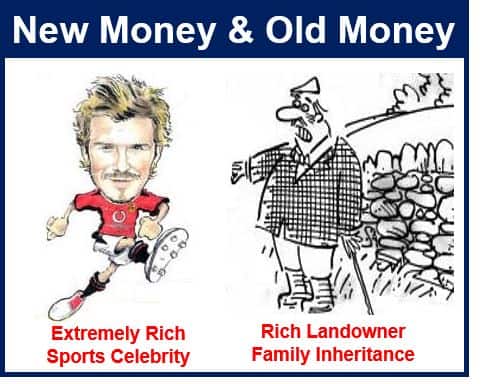What is old money?
Old Money refers to inherited wealth, which has been around for several generations. The term has slightly different meanings in the ‘New’ and ‘Old’ worlds, i.e., the US and UK.
The opposite of old money is nouveau riche, new money, or parvenus.
In the United Kingdom, when people talk about old money, they are referring to members of the aristocracy. Dukes, Earls, Marquesses, Viscounts, and Barons, for example, are aristocratic titles. The aristocracy has been part of the landed gentry for hundreds of years.
Old Money – United States
Old money, in the United States, refers to rich families that have been around for several generations. However, they are not aristocrats.
In both countries, the term describes rich people whose families have maintained their wealth over several generations.
The concept of old money is often intertwined with cultural and social capital, elements that cannot merely be acquired through financial means alone.
According to the Macmillan Dictionary, old money refers to:
“Rich families who have been rich for several generations, especially families who also have a high social status.”
Old money might also refer to locations rather than individual families.
In the United States, for example, people associate the Upper East Side of Manhattan with old money. Boston’s Back Bay and Beacon Hill, and the Grosse Pointe area of suburban Detroit have the same reputation.

-
‘Old money’ today was ‘new money’ yesterday
Ironically, old money families in the United States today are descendants of people who were described as ‘nouveau riche’ – 19th-century bankers, builders, and industrialists. These people started creating their wealth in a new way, i.e., not as traditional (Gilded Age) landowners.
Pulitzer Prize-winning American novelist, Edith Wharton (1862-1937) referred to industrialists as ‘brazen new money.’ Today, however, their wealthy descendants are part of America’s old money.
Socio-anthropologist William Lloyd Warner (1898-1970) said in the 1930s that there were two types of American upper classes:
1. The upper-upper class – they had been rich for several generations. People even viewed them as quasi-aristocratic.
2. The lower-upper class – they did not come from traditionally wealthy families. They built up their money from businesses and investments rather than inheritance.
The upper-upper class once had more prestige than the lower-upper class. However, this is not the case today.
Americans associate these surnames with old money: Roosevelt, Cabots, Lowell, Du Pont, Astor, Rockefeller, Griswold, and Forbes.
Old money – United Kingdom
In Great Britain, old money tends to refer just to the landed gentry, i.e., aristocrats and members of the nobility. These families traditionally have lived off the land. They have also inherited their wealth.
The Rothschild family set up finance houses across Europe in the eighteenth century. The family was ennobled by Queen Victoria and the Habsburg Emperor.
Throughout the 19th century, the Rothschilds controlled an immense fortune, worth trillions of dollars in today’s money.
Over the past two centuries the family, to some extent, has maintained its wealth. The British, however, do not consider the Rothschild family as old money.
Contrastingly, families like the Cavendishes, who have been associated with the Duchy of Devonshire, epitomize the quintessential British old money, boasting ancestral titles and estates passed through generations
New and old money – private banks
Elaine Moore wrote in the Financial Times in 2012 about self-made multi-millionaire Charlie Mullins who founded Pimlico Plumbers. When asked his opinion of financial advisers, Mr. Mullins said:
“I haven’t turned to banks or financial advisers. I want no involvement with them. For me, they are crooks in suits.”
Although his views may seem extreme, several private banking service providers, according to Ms. Moore, admit they find it hard establishing a relationship with ‘new money.’
Wealth managers, on the other hand, insist this is not the case. Their services are just as useful to self-made people as those who have inherited wealth, they say.
Ms. Moore quoted Philip Smith, head of Wealth Advisory at Barclays, who said:
“Entrepreneurial individuals have enormous talent and capacity which is best focused on growing their business interests . . . In a nutshell, wealth planning for first-generation entrepreneurs is around governance and succession planning – to prevent the rags to riches and back to rags in three generations story.”
The problem wealth managers have with new money people is persuading them to extend their time horizon.
Their old money clients plan several decades ahead. Self-made entrepreneurs, on the other hand, do not generally look further than ten years into the future.
Might it not be that new money people are excellent wealth managers. In other words, perhaps they are better at wealth management than the professional wealth managers of private institutions.
Employers reward their wealth managers according to how many new customers and assets they bring in. They do not reward them according to how well their investments perform. Therefore, if a wealth manager invests badly but brings in new clients, he or she gets a reward.
Maybe self-made millionaires are aware of bizarre reward system.
Two Educational Videos
These two interesting videos come from Marketing Business Network, our sister channel in YouTube. They explain what “Old Money” and “New Money” are using straightforward and easy-to-understand language and examples.
-
What is Old Money?
-
What is New Money?

